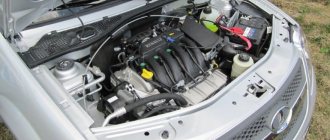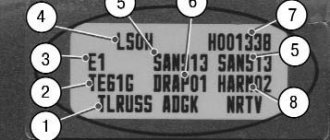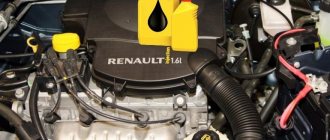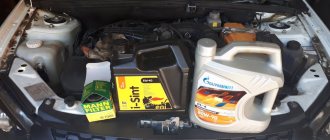The VAZ 21127 engine emerged in 2013 from the 21126 engine, completely retaining its design. Changes have been made to the design of the intake manifold - in the unit combined with the receiver, which was already used in the previous version, the developers installed dampers to regulate air flows.
ICE 21127
This, in turn, required the abandonment of the DMVR sensor; instead, DTV and DBP (air temperature and absolute pressure, respectively) are used. In other words, the designers have produced budget tuning, which is usually used by owners to independently increase engine power.
Design changes
The 21127 engine was created from the previous modification 21126 of the 2112 engine, so the main design remained the same:
- cylinder head – used from the first version 21124;
- gas distribution mechanism – DOHC scheme, two camshafts, phased injection;
- cylinder block – high type from 11183, cylinder surfaces are honed;
- connecting rod and piston group - lightweight, foreign made;
- Timing drive – belt, tooth profile rounded;
- exhaust tract - catalytic collector with a large landing size of the neutralizer;
- crankshaft - with a “long” crank radius, from 11183;
- flywheel – has a chamfer for a large diameter damper;
- ignition system – there is a separate coil for each spark plug, there are no high-voltage wires;
- fuel system – ramp with imported injectors (Siemens, Bosch);
- electronic motor control system – controllers M7.9.7 or January 7.2;
- attachments - a pump with a metal impeller has a long service life.
Receiver 21127
Fuel rail 21127
“As a legacy”, the 21127 engine received ultra-low oil consumption - only 0.1% of the amount of oil used by the system. However, for the operation of the valve and hydraulic lifter cooling system, the AvtoVAZ manufacturer’s operating manual recommends purchasing exclusively high-quality lubricant, which costs 10% more.
One of the differences
The new engine is based on the previous version of the internal combustion engine - VAZ-21126. The company did not plan to make any fundamental changes, however, there are serious differences.
The main feature is the use of a modern intake system with flaps, thanks to which air enters the cylinders a little differently. When the engine revs high, it travels a long way. At idle or low speeds, air first enters the resonance chamber. As a result, the fuel burns completely, which leads to improved performance of the VAZ-21127 engine.
Now under the hood of the car there are already 106 “horses”, although the engine volume remains the same – 1.6 liters. Moreover, this applies not only to high, but also to low speeds. And here you might think that with an increase in power, fuel consumption also increased. In fact, the efficiency remains the same. This is the same 6.7 liters per hundred kilometers.
Pros and cons of the motor
The main feature of the ICE 21127 remains the insufficient safety of the valves, which can be bent by the pistons if the timing belt breaks. The second disadvantage is the expensive overhaul, even if you do it yourself:
- the timing belt complete with automatic tensioner and pulley is expensive, as it is produced by the foreign company Gates;
- The ShPG kit also has a high price, since it is manufactured by another foreign manufacturer, Federal Mogul.
Damper control valve
The advantages of the design are:
- attachments are conveniently located, which reduces labor costs for maintenance and repairs;
- increased torque and power of the internal combustion engine.
On the one hand, the manufacturer AvtoVAZ has expanded its line of engines with version 21127. On the other hand, it has provided a new spare part - an improved receiver with an inertial charging system, which is a definite plus:
- owners of Grant, Prior and Kalin of the second generation, equipped with 21126 engines, can buy this unit;
- install it yourself instead of the standard receiver of the previous configuration;
- remove the mass air flow sensor, install DBP and DTV sensors to get a power of 106 hp. With. instead of the factory 98 hp. With.
There are no other changes in the design of the internal combustion engine; there is no need to re-register the car with the traffic police. Transport tax and insurance will be cheaper, since the plant’s vehicle certificate indicates less power.
Updated car engine
A similar oversight was taken into account and more advanced 16-valve 1.6-liter engines were installed on new VAZ 2112 cars. Structurally, the power units were not very different, but one feature was still present. In the new engine, the pistons had certain recesses, so the problem described above was eliminated.
Over the next few years, car enthusiasts began to forget about bent valves and became accustomed to the reliability of the new 16-valve engines. But the updated Priora model with a 1.6-liter power unit was an unpleasant surprise - the valves also bent when the timing belt broke.
At the same time, the final repairs were much more expensive. On the other hand, the developers made the belt as wide as possible to minimize the likelihood of the belt breaking. The only unlucky ones were those car enthusiasts who received a defective belt or those who did not take care of their “iron horse” at all.
Unfortunately, even on the new 1.4-liter Kalina engines with 16 valves, repairs cannot be avoided if the belt breaks while driving. So monitoring the state of this node is mandatory.
Which cars are equipped with ICE 21127?
Immediately after development, engine 21127 is recommended to be installed on cars manufactured by AvtoVAZ:
- Lada Granta - since 2013, Lux and Norma configurations;
- Lada Kalina-2 - since 2013, only with a manual transmission, mainly on sedans and hatchbacks;
- Lada Priora - since 2013, Luxury equipment.
Lada Priora Luxe configuration
In principle, the engine’s sufficiently high performance characteristics made it possible to install it on the Lada Largus, Vesta and X-Ray. However, by the time of their serial production, the ICE 21127 had been upgraded to the next version 21129 with a control unit that complies with Euro-5 standards, so the plant management limited itself to the indicated modifications, leaving the volumes the same.
Motor 21129
Malfunctions and repairs of the new 21127 Priora engine
Engine VAZ 21127 1.6 l. 106 hp a new VAZ engine, a continuation of the Prior engine 21126 and based on the same modified block 21083. The engine is an in-line 4-cylinder injection engine with overhead camshafts, the gas distribution mechanism is belt driven. A special feature of the 127 engine is that it was equipped with an intake system with a resonance chamber with an adjustable volume: controlled flaps reduce or increase its volume depending on the number of revolutions per minute. The chamber volume varies from larger to smaller, and the minimum volume value is used in the mode from 3500 rpm. In addition, now instead of the mass air flow sensor, DBP+DTV is installed, along with the mass air flow sensor the problem of floating speeds has gone away, and this is where the differences between the 126 and 127 engines end. At the same time, the 21127 Priors engine still bends the valves, the other problems remain the same, noise, knocking, tripping... the reasons that give rise to them are described in the article about the 126 engine. According to the sensations and reviews, the engine began to drive more interesting from the bottom than the usual 126 engine, at the top the situation is the same, the changes are insignificant, but noticeable.
Since 2015, production of a restyled version of this engine began, which was called 21129 or popularly known as the Vesta engine.
Maintenance
In order to carry out major overhauls as rarely as possible, it is recommended to service engine 21127 according to the regulations:
- The timing belt drives the timing pulleys for 20–50 thousand km, but it needs to be inspected three times more often;
- The oxygen sensor has a slightly shorter service life - 10 thousand hours;
- The cooling system and the antifreeze itself, filters and fuel tank cap can withstand 40 thousand km of operation;
- the threshold of 25 thousand mileage cannot be overcome by spark plugs, belts and attachment belts;
- The filter along with the oil is changed every 10 thousand km.
To save budget, the internal combustion engine device allows you to perform all the specified maintenance operations in the garage without visiting service stations.
Typical breakdowns, causes, elimination
Since the 21127 motor uses a lightweight ShPG, as a result of a sudden belt break, the piston is 100% guaranteed to bend the valve. In addition, there are “diseases” characteristic of this motor:
| Power reduction | 1) burnt out valves 2) clogged air filter 3)fuel system malfunction 4) clutch slipping 5) wear of camshaft cams | 1)replacement of valves 2) cleaning or replacing consumables 3) cleaning and repair 4) clutch replacement 5) installation of a new camshaft |
| The internal combustion engine runs after the ignition is turned off | 1) carbon deposits inside the combustion chambers and on the valves 2) Problems with the ignition switch | 1)washing with a cleaning agent 2)replacing the ignition switch |
| Emergency pressure lamp comes on | 1) wear of the oil pump or main bearings 2) short circuit 3)low oil level | 1) replacement of parts 2) electrical repair 3) adding lubricant to the level |
In principle, no special complaints were noticed with the ICE 21127; this power drive is considered reliable and economical to operate.
Recommendations for choosing engine oil
Based on the type of engine installed in the car, there are general recommendations for choosing car oil. Thanks to these recommendations, you will not go wrong in your choice. There are four nuances that you should pay attention to.
The first nuance that should be taken into account is, of course, the advice of automakers. And this, in fact, is the law, because only the manufacturer can provide accurate data on the fuels and lubricants needed for the car.
The second nuance is the characteristics of the area where this vehicle will be used.
The third nuance is the degree of engine wear (this can be determined by the mileage on the speedometer or through a computer).
The fourth nuance is directly related to the third. The oil that was filled last time is taken into account. If semi-synthetics were previously poured into the car, then it is not uncommon for specific plugs to form in cracks in the rubber. In this case, if the replacement occurs with synthetics, all these plugs will be washed and compression in the engine will not be impaired.
Engine tuning
Initially, engine 21127 had already received factory tuning, but there were still opportunities to further increase power:
- In addition to the standard receiver, a damper with a diameter of 54 mm is mounted to achieve a performance of about 110 liters. With.;
- another 10 l. With. will be added by replacing the exhaust catifold with a “spider”;
- The Stolnikov camshaft modification 8.9 will provide power in the upper speed range.
Tuning 21127
Complex tuning is possible by installing a Stolnikov 9.15 camshaft with a phase shift of 316 degrees, replacing injectors with Bosch 431 360 (more efficient compared to standard ones) and milling the valve seat stages. In this case, the internal combustion engine will receive about 150 hp. With.
Thus, motor 21127 is an industrially tuned version of the previous internal combustion engine 21126. The characteristics are improved only by modifying the intake air system (damper inside the receiver plus DBP, DTV).
If you have any questions, leave them in the comments below the article. We or our visitors will be happy to answer them
Malfunctions and repairs of the new 21127 Priora engine
Engine VAZ 21127 1.6 l. 106 hp a new VAZ engine, a continuation of the Prior engine 21126 and based on the same modified block 21083. The engine is an in-line 4-cylinder injection engine with overhead camshafts, the gas distribution mechanism is belt driven. A special feature of the 127 engine is that it was equipped with an intake system with a resonance chamber with an adjustable volume: controlled flaps reduce or increase its volume depending on the number of revolutions per minute. The chamber volume varies from larger to smaller, and the minimum volume value is used in the mode from 3500 rpm. In addition, now instead of the mass air flow sensor, DBP+DTV is installed, along with the mass air flow sensor the problem of floating speeds has gone away, and this is where the differences between the 126 and 127 engines end. At the same time, the 21127 Priors engine still bends the valves, the other problems remain the same, noise, knocking, tripping... the reasons that give rise to them are described in the article about the 126 engine. According to the sensations and reviews, the engine began to drive more interesting from the bottom than the usual 126 engine, at the top the situation is the same, the changes are insignificant, but noticeable.











